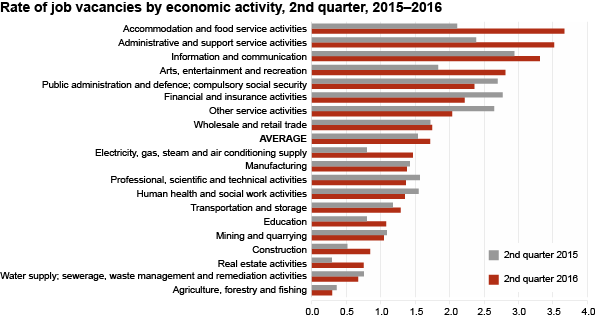In the 2nd quarter, the number of job vacancies exceeded 9,000
The rate of job vacancies, i.e. the share of job vacancies in the total number of jobs, was 1.7% in the 2nd quarter of 2016, being 0.2 percentage points bigger than in the previous quarter and in the 2nd quarter of 2015.
The rate of job vacancies was the highest in accommodation and food service activities (3.7%), administrative and support service activities (3.5%) and information and communication (3.3%); and the lowest in agriculture, forestry and fishing (0.3%), water supply (0.7%), construction (0.8%) and real estate activities (0.8%).
The total number of posts and the number of vacant posts continued to be the highest in manufacturing and wholesale and retail trade. Compared to the 2nd quarter of 2015, the number of job vacancies grew the most in real estate activities, accommodation and food service activities and in electricity, gas, stream and air conditioning supply. Year-over-year, the number of job vacancies dropped the most in agriculture, forestry and fishing, mining and quarrying and other service activities.
70% of the vacant posts were in Harju county (including Tallinn), followed by Tartu county (9%) and Ida-Viru county (5%). The rate of job vacancies was still the highest in Harju county (2.1%) and the lowest in Viljandi (0.7%), Hiiu (0.8%) and Rapla counties (0.8%).
7,200 job vacancies (76%) were in the private sector and 2,300 (24%) in the public sector. In the 2nd quarter of 2016, the rate of job vacancies was the highest in foreign private sector institutions (2.5%) and state institutions (2.1%) and the lowest in Estonian private sector organisations (1.5%) and local governments (1.1%).The movement of labour is characterised by labour turnover (the total of engaged employees and those who have left), which amounted to 73,000 in the 1st quarter of 2016, denoting an 8% increase compared to the previous quarter and a 19% increase compared to the 1st quarter of 2015. Compared to the 1st quarter of 2015, the largest increase in labour turnover occurred in mining and quarrying, water supply, agriculture, forestry and fishing, and information and communication.
The data are based on the job vacancies and labour turnover survey conducted by Statistics Estonia since 2005. In 2016, the sample includes 12,603 enterprises, institutions and organisations; the data of randomly selected units are imputed to the total population separately in each stratum. As of the 2nd quarter of 2016, Statistics Estonia uses the data of the Employment Register of the Estonian Tax and Customs Board to pre-fill the survey questionnaires.
The number of job vacancies is the total number of job vacancies on the 15th day of the second month of a quarter. A job vacancy is a paid post that is newly created, unoccupied or becomes vacant when an employee leaves, and for which the employer is actively trying to find a suitable candidate from outside the enterprise, institution or organisation concerned.